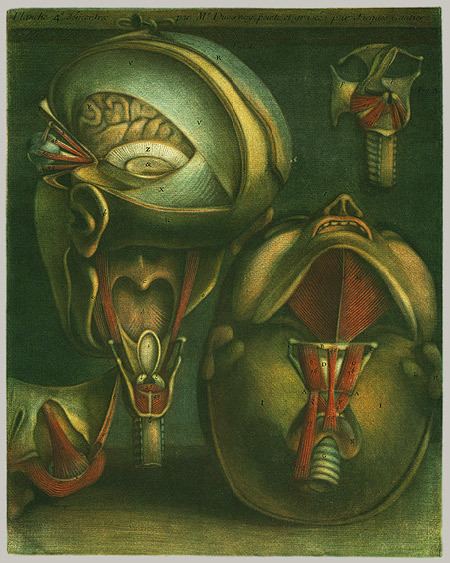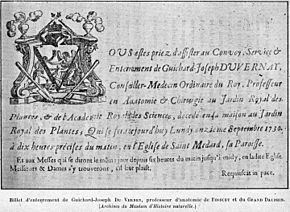Nationality France Occupation anatomist | Name Guichard Duverney | |
 | ||
Born 5 August 1648 Feurs Known for otology
Duverney fracture
discovery of occipital sinuses Died September 10, 1730, Paris, France Books A Treatise of the Organ of Hearing | ||
Guichard Joseph Duverney or Joseph-Guichard Du Verney (5 August 1648 – 10 September 1730) was a French anatomist.
Contents

Biography

Du Verney was a native of Feurs in the province of Forez. His father Jacques Duverny was a doctor in the small community Feurs. His mother was born Antoinette Pittre.
He studied medicine in Avignon, where in 1667 he obtained his medical degree. Shortly afterwards, he relocated to Paris. In 1676 he became a member of the Académie des sciences. He is considered by many to be the founder of scientific otology.
He is remembered for his anatomical exhibitions at the Jardin du Roi, where in 1682, he was given a professorship. His lectures became an attraction for the lay public.
Alongside Claude Perrault (1613-1688) and Jean Pecquet (1622-1674), he was influential in the renewal of anatomical studies. Some of his students attained notoriety: Pierre Dionis (1643-1718), Jacques-Bénigne Winslow (1669-1760), Jean-Baptiste Sénac (1693-1770) and François-Joseph Hunauld (1701-1742).
He was sent, with Philippe de La Hire (1640-1718), to study the fish off the coast of Brittany in 1680. In 1681, he dissected an elephant before king Louis XIV.
Contributions to science
Duverney published one of the earliest comprehensive works on otology (Paris, 1683): Traité de l'organe de l'ouie, contenant la structure, les usages et les maladies de toutes les parties de l'oreille (Treatise on the organ of hearing, containing the structure, function, and diseases of all parts of the ear). In the book he discusses the anatomy, physiology and diseases associated with the ear.
Duverney's theory of hearing (which he conceived with the help of physicist Edme Mariotte) was fundamentally similar to what physiologist Hermann von Helmholtz (1821–1894) later proposed in the mid-19th century, except that he thought that high frequency would resonate near the apex of the cochlea, and low frequencies near the base (Domenico Cotugno had to turn this around in 1760).
In 1683, Duverney identified a temporal bone tumor, which is believed to be the earliest description of cholesteatoma. He realized the importance of the Eustachian tube and its role in adjusting air pressure in the tympanic cavity. However, he believed that the Eustachian tube was always open, acting as a vent to the air, when the eardrum moves in and out.
Duverney's clinical work led to the posthumous publication of: Maladies des os ("Diseases of the bones"), a book containing a description of the eponymous "Duverney fracture" and the first full description of osteoporosis.
